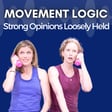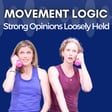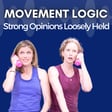
102: The Problem with Moralizing Movement
In this episode of the Movement Logic Podcast, Laurel explores how we’ve come to assign moral value to certain movement concepts—like compression, flexion, anterior tilt, and instability—and why that language does more harm than good. She unpacks how terms that are neutral by definition often get rebranded as “bad,” “dangerous,” or “dysfunctional” in movement and rehab spaces.
Rather than offering a list of “better” movement cues, Laurel invites listeners to step outside of binary thinking. This episode explores how our wiring, combined with marketing and group identity, fuels a polarizing narrative—a red-X/green-checkmark mentality that pits “functional” against “dysfunctional.”
Whether you’re a teacher, coach, or curious mover, this episode offers a reminder: biomechanical concepts are just descriptions of what’s happening—not value-laden truths. And when we let go of moralizing movement, we open the door to more creativity, exploration, and individualized problem-solving.
Sign up for our Bone Density Mini Course: Barbell 101!
Follow us on Instagram @movementlogictutorials
Resources:
The Truth About Good vs Bad Muscles - Results Not Typical Podcast
98: Capacities for Longevity Part 3 - Cardio
94: Capacities for Longevity Part 2 - Power
90: Capacities for Longevity Part 1 - Strength
89: Is Dead Butt Syndrome Real?
80: Posture Panic Pt. 3 with Author Dr. Beth Linker, PhD
79: Make Yoga U Make Sense
78: Behemoth Knee Myths
76: Posture Panic Part 2
74: McGill We Go Again
73: Posture Panic Pt. 1
67: Popular Explanations for SI Joint Pain are Wrong, Says Science
66: Dismantling Long and Lean Pt. 3
63: Dismantling Long and Lean Part 2
62: Make McGill Make Sense
58: Alignment Dogma - Shoulders
54: Alignment Dogma - Spine
48: Alignment Dogma - Pelvis
19: Oh, NO! Nose Breathing and Nitric Oxide
Review: Effect of training and lifting equipment for preventing back pain in lifting and handling: systematic review
Review: Stoop or squat: a review of biomechanical studies on lifting technique


